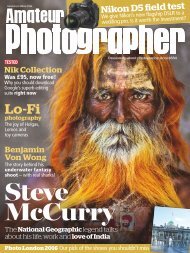You also want an ePaper? Increase the reach of your titles
YUMPU automatically turns print PDFs into web optimized ePapers that Google loves.
S. OSSOKINE, A. BUONANNO (MAX PLANCK INSTITUTE FOR GRAVITATIONAL PHYSICS), D. STEINHAUSER (AIRBORNE HYDRO MAPPING GMBH)<br />
ASTRONEWS<br />
MOON VILLAGE. In late February, the head of the European Space Agency announced plans for a permanent<br />
Moon base to follow the International Space Station. So far, few other details exist.<br />
GRAVITATIONAL WAVES —<br />
SEEN AND HEARD?<br />
12h<br />
Starting with the announcement on<br />
February 11 that scientists had detected<br />
gravitational waves for the first time, a<br />
flurry of related studies have appeared as<br />
researchers around the world joined in the<br />
gravitational wave craze.<br />
The Laser Interferometer Gravitationalwave<br />
Observatory (LIGO) detected the signal<br />
of two colliding black holes September 14,<br />
2015. And while the LIGO team was hard at<br />
work verifying the signal and writing up the<br />
paper, it also reached out to other observatories<br />
in search of corroborating evidence.<br />
Some of LIGO’s potential gravitational<br />
wave sources include collisions between<br />
neutron stars (the dense cores of stars after<br />
their ordinary lives end as supernovae)<br />
or between neutron stars and black holes.<br />
These events should give off gamma-ray<br />
bursts followed by afterglow across the<br />
spectrum that fades on the order of hours to<br />
days. In order to track these events, followup<br />
observations are built into the LIGO<br />
process; in fact, LIGO tested such follow-up<br />
searches during the initial science run in<br />
2009 for a handful of detections that proved<br />
insignificant.<br />
In all, 74 partners signed up with LIGO,<br />
encompassing both ground- and spacebased<br />
observatories. Whenever LIGO<br />
sees a detection — even before it has been<br />
verified — these observatories coordinate<br />
to search the skies for potential electromagnetic<br />
matches to a gravitational wave<br />
event. But they have to search a lot of sky.<br />
With only two stations, in Louisiana and<br />
COSMIC COLLISION. This simulation of two<br />
colliding black holes shows the black holes near<br />
center and the gravitational waves in vibrant colors,<br />
though no visible light should be emitted.<br />
0°<br />
–30°<br />
16h<br />
Sun<br />
Moon<br />
–60°<br />
20h<br />
Washington state, LIGO can identify the<br />
general direction of a source by which station<br />
first detects it, but it can’t point to a<br />
precise position.<br />
Theoretically, two colliding black holes,<br />
the source of LIGO’s only known detection<br />
so far, should not emit any electromagnetic<br />
radiation. And 24 of 25 teams that<br />
responded to LIGO’s call reported no suspicious<br />
detections. Yet the Fermi Gamma-ray<br />
Space Telescope may have spotted something,<br />
flying in the face of theory. It caught<br />
a weak gamma-ray burst less than half a<br />
second after LIGO intercepted the gravitational<br />
waves, and in the right direction. A<br />
fellow gamma-ray observatory, INTEGRAL,<br />
could not verify Fermi’s detection, but given<br />
the burst’s weakness and the differences<br />
between the two telescopes, this does not<br />
mean Fermi’s sighting is unreal.<br />
But if colliding black holes don’t give<br />
off electromagnetic radiation, then what<br />
did Fermi see? Avi Loeb, an astronomer<br />
at Harvard University, suggested in a<br />
paper published in the March 10 issue of<br />
The Astrophysical Journal Letters that the<br />
answer might go beyond just two black holes<br />
8h<br />
24h<br />
GW<br />
Radio<br />
Optical/infrared<br />
X-ray<br />
SEARCHING THE SKY. Observatories searched the spectrum from gamma rays to radio waves for electromagnetic<br />
signals to match LIGO’s gravitational wave event. LIGO narrowed the source’s origins to within the<br />
black contours, and partner observatories (radio searches in red, optical in green, X-ray in blue, and all-sky<br />
gamma ray searches not shown here) searched the area in a patchwork collaboration. ABBOTT ET AL., 2016<br />
crashing together. He posits a single massive<br />
star — more than 100 times the Sun’s mass<br />
— that collapsed in a supernova event into<br />
a dumbbell shape, forming two black holes<br />
separated by only 1,200 miles (2,000 kilometers),<br />
which then quickly smashed together.<br />
Furthermore, astronomers think that a common<br />
way to form such enormous stars is to<br />
merge two smaller suns, meaning the joint<br />
Fermi-LIGO detection — if real — might<br />
indicate a chain of cosmic collisions.<br />
Until LIGO detects more events, and<br />
until it can better pinpoint the locations<br />
for its observing partners, some details<br />
of gravitational wave origins will likely<br />
remain a mystery. But help is on the way<br />
from similar gravitational wave observatories<br />
across the world: Virgo in Italy will<br />
begin a testing phase later this year, and<br />
KAGRA in Japan should be completed in<br />
2018. LIGO India was approved February<br />
17 and could be online as soon as 2023.<br />
Every additional station will better enable<br />
the LIGO collaboration to dig smaller<br />
signals out of the noise, and to zero in on<br />
their origins. The era of gravitational wave<br />
astronomy is just beginning. — K. H.<br />
16 ASTRONOMY • JUNE 2016






